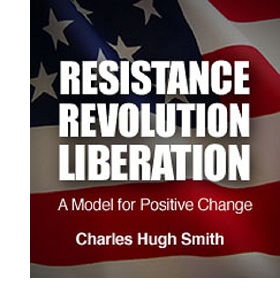Linear extrapolations based on the "one-off" commodities/debt bubble boom of the past 20 years fail to account for the non-linear dynamics of technology and changes in behavior.
The causal relationship between scarcity, demand, and price is intuitive. Whatever is scarce and in demand will rise in price; whatever is abundant and in low demand will decline in price to its cost basis.
The corollary is somewhat less intuitive, but still solidly sensible: the cure for high prices is high prices, meaning that as the price of a commodity or service reaches a threshold of affordability/pain, suppliers and consumers will seek out alternatives or modify their behaviors to lower consumption.
We talk about the demand for commodities being elastic or inelastic, meaning that some commodities such as oil and grain are so essential that the demand for them is less elastic than demand for discretionary goods and services. Despite its essential role in the global economy, the demand for oil is not fixed; as prices rise, demand falls. Since all commodities are priced at the margin, the price of oil is actually quite volatile, despite the supposed inelasticity of demand for oil.
Scarcity is only one price input. Another is the cost basis of the good or service. If shale oil costs $50 per barrel to extract, refine, and ship to market, no supplier can sell it for less than $50/barrel for long.
This leads to an apparent paradox: Demand can be robust and supplies can be abundant, yet prices can still be high, but not high enough to trigger a profitable search for alternatives if the “pain” felt by consumers does not reach a behavior-modifying threshold.
There is another input to price: opportunity cost, a concept that describes the relationship of scarcity and choice. If grain rises in price, consumers could choose to eat less meat, as grain is the primary cost input to the price of meat. The opportunity cost is what they could have done with the money saved by eating less expensive vegetable protein rather than continuing to buying high-priced meat.
The point here is that scarcity remains a critical input to the price of goods and services, but the cost basis and opportunity costs are equally important inputs.
Since the world’s resources are finite, it’s easy to extrapolate linear demand and predict much higher prices for ultimately scarce commodities. But such predictions often fail to account for behavioral and technological changes that lower or shift demand.
Let’s say that copper and cement skyrocket in price as demand for new housing surges globally. In a linear projection of demand and supply, we might predict higher prices for new homes far into the future. But the supply of housing is not as inelastic as many imagine; for example, the density of residents per dwelling is remarkably low in the U.S., and so a very modest increase of density (i.e., more people living in existing dwellings) has an enormous impact on demand for new housing.
The opportunity cost of buying a home has also changed radically since the real estate bubble burst. Potential buyers are calculating the opportunity cost not just in terms of mortgage payments but in terms of being stuck in a locale should home prices decline further. Owners of homes with empty bedrooms are realizing that the Web has simplified access to a large market of potential renters.
Linear projections of higher prices based solely on demand and scarcity fail because they do not include feedback loops from behavioral options, opportunity costs, technological innovations, and the cost basis of goods and services.
Access and Ownership
Much of the supposedly inelastic demand for goods is based on the presumptive value of ownership. We presume future generations will covet owning a vehicle that requires enormous quantities of materials to manufacture, maintain, and fuel, and that they will demand an expansive home that sucks up stupendous resources to build and maintain.
But what if future generations of consumers instead prefer 'access' to ownership?
Sharing (renting) existing resources for transport and housing would slash demand for costly “money/resource pits” such as vehicles and houses, and demand for the commodities used in their manufacture would decline, possibly seriously.
It is not inconceivable that a large household of eight adults could manage quite well sharing a single vehicle and using public transport, even if they would at one time have purchased eight vehicles (one for each adult) when each lived in their own dwelling.
This trend of eschewing ownership of autos and homes is already well-established among young people in Japan, and is an increasingly visible trend in the U.S. and other developed economies.
Access to transport and housing is sufficient; ownership is not necessary. This reality (which can be described as the systemic reappraisal of the opportunity cost of ownership) will have a profound impact on demand for ultimately scarce commodities.
Income and Scarcity
There is another reason that ownership of resource-intensive assets such as autos and houses is declining on a structural level. Incomes are declining for all but the top 10% of households, and this trend is likely to accelerate as financialization’s self-destruct sequence pushes the global economy into a deep, and very likely prolonged, recession.
Many analysts (including me) have discussed this decades-long decline in the purchasing power of labor. The primary takeaway is that this trend is the result of structural forces that cannot be “fixed” by a political policy du jour or central bank intervention. I have described this misalignment of Central Planning goals and tools many times. The tools available cannot possibly accomplish the tasks at hand. Metaphorically speaking, central banks are trying to pound nails with handsaws, as they have no hammers in their toolboxes.
For many workers, there simply won’t be enough income to indulge in the ownership model. The cost in cash and opportunity are too high.
This leads to a profound conclusion: What will be scarce is income, not commodities. The corollary is equally profound: All the capital that has been sunk into pursuit of commodities and ownership-model assets such as homes and vehicles is in danger of becoming trapped capital. That is, if there is little demand for commodities and resource-intensive ownership-model assets, there will be little demand for these capital-intensive assets.
Another way of describing trapped capital is to say that it is illiquid, meaning that when you place the asset for sale on the open market, there are few buyers at any price above liquidation value.
What Will Be Scarce: Liquidity and Reliable Income Streams
If we follow this chain of evidence and reasoning, we conclude that what will be scarce going forward are not commodities or resource-intensive, ownership-model assets but liquidity and reliable income streams. Ownership-model asset bubbles and the commodity/equity bubbles that arose as a result of ownership-model demand have lumbered off into the sunset.
This realignment of scarcity, demand, cost basis, opportunity cost, technology, and behavioral choice has important implications for investors. In
Part II: Why Local Control is the Best Way to Preserve Wealth, we study these implications and identify the best use of investment capital for the arriving future.
This entry was originally published on peakprosperity.com, where I am a contributing writer.
 Resistance, Revolution, Liberation: A Model for Positive Change (print $25)
Resistance, Revolution, Liberation: A Model for Positive Change (print $25)
(Kindle eBook $9.95)
We are like passengers on the Titanic ten minutes after its fatal encounter with the iceberg: though our financial system seems unsinkable, its reliance on debt and financialization has already doomed it.We cannot know when the Central State and financial system will destabilize, we only know they will destabilize. We cannot know which of the State’s fast-rising debts and obligations will be renounced; we only know they will be renounced in one fashion or another.
The process of the unsustainable collapsing and a new, more sustainable model emerging is called revolution.Rather than being powerless, we hold the fundamental building blocks of power. We need neither permission nor political change to liberate ourselves. A powerless individual becomes powerful when he renounces the lies and complicity that enable the doomed Status Quo’s dominance.
| Thank you, Greg G.($5/month), for your exceedingly generous subscription to this site-- I am greatly honored by your support and readership. |
 Resistance, Revolution, Liberation: A Model for Positive Change (print $25)
Resistance, Revolution, Liberation: A Model for Positive Change (print $25)

























